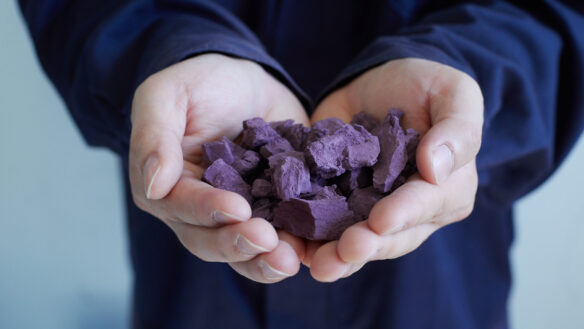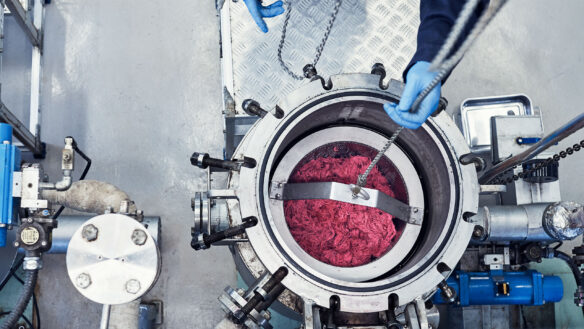One of the biggest challenges facing today’s fashion industry is how to create fashion for a growing population, while at the same time improving its impact on the environment.
According to Ellen MacArthur Foundation, 97% of all materials used to produce clothes come from virgin resources. Out of the 3% that are recycled materials, only 1% is recycled textile.
At the same time, the number of times a garment is worn has dropped globally by 36% between 2002 and 2016. Some garments are estimated to be thrown away after just seven to ten wears. It’s a trend we need to stop to protect the exhaustion of our planet. Instead of producing more, the life of garments must be extended.
However, once a garment has been worn-out, all textiles must ultimately be recycled. Garment recycling together with changed behaviour, technology, consumption and business models, makes up a required paradigm shift in the fashion industry. If this shift will not happen, our planet will not cope.
From cleaning cloths to new garments
In 2016, we joined forces with The Hong Kong Research Institute of Textiles and Apparel (HKRITA), to accelerate the research on textile recycling. The goal is to find at least one commercially viable recycling method for blend textiles.
“In this project we have together over 500 years of engineering experience. We’re convinced we can solve some of the industry’s – and ultimately our planet’s – challenges.”
Erik Bang, Innovation Lead H&M Foundation
Blend textiles make up a majority of all garments made, just look at what you are wearing. However, today there is no method to recycle blend textiles at scale. Instead, if the garments do end up in a recycling process, the fibres are usually torn apart and used for downcycling, such as cleaning cloths and filling in car seats, since the quality loss makes it impossible to make new garments out of it.
In a circular fashion world, downcycling and value loss is not an option. This is what our project aims to change. We call it the Recycling Revolution.
Towards a circular fashion industry
The Recycling Revolution, co-funded by the Innovation and Technology Fund of Hong Kong SAR Government, is one of the biggest and most comprehensive research efforts ever for textile recycling. Recycling of blend textiles at scale is an important step towards a circular fashion industry.
As a non-profit foundation, we aim to drive change for the entire industry. In practice, this means that we are transparent with the steps forward (and backward) we’re taking along the way, and the technologies found will be licensed free for maximum impact.
Our research focus
Learn more about the three technologies we’re focusing on:
- The Green Machine: A hydrothermal process that can fully separate and recycle cotton and polyester blends into new fibres and cellulose powder, a full-scale machine is now being implemented at a factory in Asia.
- The Brewery: Explores a biological method to recycle blends, the goal is to use a low energy, low impact method to effectively recycle used materials.
- The G2G: A miniaturized recycling machine, to make consumers understand the possibilities of garment recycling and nudge them to hand in their unwanted clothes for recycling instead of throwing it away.
The collaboration in detail
The Recycling Revolution is made of a portfolio of several sub projects and features, focusing on the full circle of what is needed to close the loop for fashion. The scope includes research on several methods for recycling, as well as sorting and de-colouring, as these are core challenges for a commercially viable textile recycling solution.
Within recycling, the project explores different methods to separate and recycle fiber blends made from the three main types of textile material:
- synthetics
- cellulose
- animal fibres
As textile today is available in an almost endless variety of blends and treatments, it’s likely that several complementing technologies will be needed to fully solve for recycling.
HKRITA uses applied research, meaning using existing science and technology in new ways to address new challenges. This approach quickly generates insights and results. For example, the project investigated and tested over 25 different approaches to textile separation and recycling before focusing on the two most promising methods, presented above as The Green Machine and The Brewery.
Ground-breaking results
Recycling Revolution started in 2016 and will run for four years. However, only a year after the project started a breakthrough was made – the researchers found a way to recycle blend textiles in a hydrothermal process that could be done at scale with no quality loss. We are currently upscaling the system, called The Green Machine.
1%
The total share of recycled textiles used in garment production.
$500b
Estimated value of what is lost every year due to clothing being barely worn and rarely recycled.
1
Ground-breaking method for recycling cotton and polyester blends is now being built at a factory to be used at a commercial scale for the first time.


